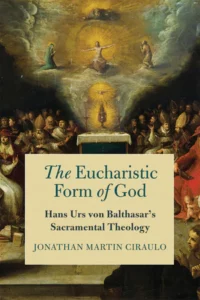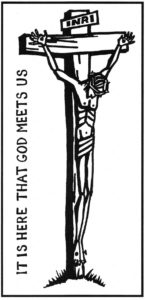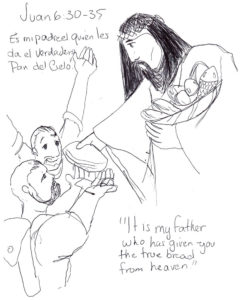Some years ago Allison Ogle, one of the dedicated young Catholic Workers at Casa Juan Diego, introduced us to her fiancé (now her husband) Jonathan Ciraulo. Jonathan was a graduate student of theology at the University of Notre Dame; he has since received his doctorate and is teaching at St Meinrad’s School of Theology. The University of Notre Dame has just published the book which is the fruit of his doctoral studies: The Eucharistic Form of God: Hans Urs von Balthasar’s Sacramental Theology.
 “Glory is eternal love descending into the uttermost darkness. The liturgy is a mirror for this.” – Hans Urs von Balthasar (159).
“Glory is eternal love descending into the uttermost darkness. The liturgy is a mirror for this.” – Hans Urs von Balthasar (159).
Balthasar is famous for his dense volumes about the Glory of the Lord as well as his presentation of Theo-Drama , among many others.. As Jonathan Ciraulo points out, however, he did not write a major work on the Eucharist, but rather his theological reflections on the Eucharist are scattered throughout his articles and other works. In The Eucharistic Form of God Ciraulo explores the various aspects of Balthasar’s theology of the Eucharist from his large corpus of writings in a beautiful, albeit challenging synthesis of his sources and theology. Ciraulo includes Balthasar’s reflections from the book of Revelation, Irenaeus, the mystics, Bernanos, poets Péguy and Dante, and even phenomenologists. We encourage scholars and other serious readers to explore this profound and inspiring book in its entirety.
This article will focus on one theme from the book, that of Liturgy and Slaughter. We know that Christ is the center of history. But how can we reconcile the horrors of much of history with God’s plan and presence? Ciraulo’s reflections on this theme through the eyes of Balthasar can help us meditate on how the glory of God, the mission of his Son and the kenosis of the Son on the cross, the role of the Holy Spirit, and God’s plan for the world intersect and engage with what has been happening in human history – so much of it violent and disappointing – and how we can imitate Christ’s self-giving in the midst of it all, even as we cry out to God for his help.
Liturgy and Slaughter
As I studied The Eucharistic Form of God, two newly paralyzed immigrants came to the door seeking help. One man was the victim of a random shooting as he and his wife finished shopping at a meat market in Houston, and the other very young man fell from a tree while seeking refuge from the border patrol as he sought to enter the United States. The future is bleak for these men. They came to help their families, but they gave up even the gift of walking in their effort to do so. Now what can they do? If they had been born a few hundred miles closer, this would not have happened. People should not have to hide in trees to feed their families.
Going back to the book on Balthasar’s theology I realized again how difficult it is for a Christian, believing in a God of love, mercy, and glory to know what to think and how to respond in thought, prayer, and action to the horrors that have plagued the world: centuries of wars, colonialism, genocide, and countless others. Now each day in this supposedly enlightened time, images of street encampments of immigrants and refugees at the border seeking an opportunity to apply for asylum, images of millions of displaced and murdered people from wars in Ukraine, in Yemen, in many African countries, and images of mass shootings, slaughter in our schools and communities here in the United States come across our television and computer screens.
The Slaughter of Immigrants
Daily at Casa Juan Diego we see the results of one of the most prevalent occurrences of violence and slaughter—in the treatment of refugees and immigrants. The violence is in the separation of children from their parents, creating lifelong trauma or PTSD. It is in the separation of wives from husbands, adult children from parents and from their brothers and sisters. (We are frequently trying to help families locate their family members.) The violence is in the prison conditions for those seeking refuge and asylum. Violence is in the deportations to dangerous conditions where immigrants and refugees are kidnapped and slaughtered, in the deportation to sure persecution and death in many countries, and the willful ignoring of the many migrants lost at sea. Violence is in the voices that demean immigrants and refugees as less than persons.
Turning to the Liturgy in the Midst of Violence and Darkness
How does celebrating the liturgy relate to violence and suffering? Some believers ask how one can possibly see the tragedies of history through the eyes of faith, or even whether one can go on believing after events of ruthless brutality and destruction of lives. Others demand retaliatory violence.
The Eucharistic Form of God provides insights can that guide us in our prayer amidst the terrible realities, the slaughter in our world. We can turn to the liturgy in the midst of darkness. “Ultimately, then, the one who will account not only for sin but also for suffering is Christ, who takes upon himself the entire horror of humanity in history.” (181) This is the Lord who is present in the Eucharist.
As we struggle to understand violence in the light of faith, it may help us to realize (as Ciraulo points out with Balthasar) that “Christ’s response on the cross was not understanding, but eucharistic self-abandon in order to transform slaughter into liturgy.” (184)
Balthasar’s sources include poet Charles Péguy: “Balthasar sees in Péguy a truly Christian answer to the liturgy/slaughter tension… Péguy commends hope…, a hope that in the end the liturgical consummation of the Son to the Father is extended to include and heal the winding paths of history.” (187) And the book of Revelation.
Psalms of Lament
Violence is not new, nor is the response of God’s people to pray when facing it. In the course of salvation history, all through the Hebrew Scriptures, when cruel wars and brutality threatened, the chosen people continued to pray. Balthasar writes: “It was possible, even in the Old Testament tradition, to worship God’s majesty amid the confusions and collapses of the world as such.” Their liturgical prayer was filled with the Psalms, including Psalms of Lament in difficult times. Ciraulo adds: “The Psalms of Lament indicate that Israel still prays even when all cause for praise and thanksgiving seem to be taken away” (191).
Many of the Psalms are Psalms of Lament. The word lament may lead us to think that these are Psalms of complaint, but they are not simply complaints about what may be happening. They are a crying out to God that He may hear our prayers in the face of persecution and death. It may not be our own death, but we join our prayers in solidarity with those who suffer.
The Psalms of Lament, sung throughout the centuries as prayers of petition, count on the Old Covenant that God made with his people so long ago. We count now on the New Covenant as we pray these Psalms today. Balthasar said: “In the Eucharist of his surrendered Son, God concludes his new and eternal covenant with mankind, committing himself to it utterly and with no reservation.” (22) The Psalms of Lament are very much a part of the Divine Office, the Liturgy of the Hours, prayed by Catholic Christians around the world now from the perspective of Jesus in the Psalms.
The Lord’s Death and the Eucharist
Christ suffered a very violent death, crying out in the words of one of the Psalms of Lament at the time of his crucifixion, “My God, my God, why have you abandoned me?” (Psalm 22). The wounds on the body of the crucified Lord stayed with him, even as he rose from the dead and ascended into heaven. (Remember Thomas who put his hand in the Lord’s side in order to believe.) Jesus, present in the Eucharist, is the Lamb who was slain.
Ciraulo reflects: “In almost every discussion of the Eucharist, Balthasar turns to language that serves to highlight the violent origins of the sacrament… He rarely says simply ‘Christ’s body and blood,’ but instead draws on a host of adjectives: it is ‘torn flesh,’ ‘slaughtered flesh,’ and ‘poured-out blood’ and it is the body in its state ‘of being torn,’ ‘the blood in its state of being shed’ that are offered to us as food and drink.” (25)
Balthasar teaches that the very intent of the Incarnation and the Cross was to bring the Eucharist to the world. As Ciraulo summarizes: “Thus, if the drama of the Incarnation was a saving event, the Eucharist is its application or reverberation in history. And, for Balthasar, because the reverberation was the goal from the beginning, the Incarnation was always oriented toward Christ becoming bread, and more specifically, the cross was not so much an end in itself, but rather the means by which Christ became eucharistic. “(25)
Some have suggested that Balthasar was speculating too far. Jonathan Ciraulo places him very much in the tradition which has maintained the “indissoluble link between the Eucharist and the cross.” Balthasar worried “that this connection is being lost, which is why he complains that the Eucharist is ‘so poorly understood and watered-down by many theologians and preachers.’” (26)
The Eucharist Can Change Us, Transform Us
It is important that we focus on the changing of the bread and wine into Jesus, but likewise important is the change that must take place within us at the Eucharist so that we might in some small way help to bring the presence of Christ to our world. Otherwise, the Eucharist is, for us, almost an empty rite.
Balthasar emphasizes the Lord’s kenosis, his free self-surrender, and the invitation to respond with ourselves as a reciprocal self-gift at the Eucharist.
If we cooperate with our will and our heart as we receive the Eucharist and abandon ourselves to Divine Providence (as in Caussade’s spiritual classic), we can be transformed to be more like Christ. We can participate in His mission to save a world filled so often with violence and the atrocities of war, joining our prayers and our hope to the crucified and risen Christ. We cannot do this on our own. We need the gift of the Holy Spirit to help us as well as communion in the Mystical Body of Christ, communion with so many saints to support us.
Liturgy Not Just for Specialists and Asthetes, but
Especially Brings Strength to Ordinary People
The importance of the liturgy in our lives as Christians in the world cannot be underestimated.
But the most rarified liturgies, however beautiful, are not the only valuable ones. According to Ciraulo, Balthasar was influenced by Romano Guardini who wrote about how ordinary persons can find the strength to continue on in their daily lives through the Mass. He includes this Guardini text, quoted by Balthasar: “The many people who…merely seek strength for their daily toil—all these penetrate far more deeply into the essence of the liturgy than does the connoisseur who is busy savoring the contrast between the austere beauty of a Preface and the melodiousness of a Gradual.”
Ciraulo adds, “Those who come to the liturgy to encounter Christ, or even more basically, to ‘seek strength for their daily toil’ are the true participants, the true liturgical actors, even if they fail to grasp the marvelously arranged liturgical performance” (160).
What Can We Do in the Face of Violence and Slaughter?
May we seek strength in the liturgy as we lament the brutality of wars in which even our own country participates as we sell or sometimes give arms to country after country around the world – even though we cannot understand the atrocities.
On the themes of the Psalms of Lament and abandonment to God, respected biblical scholar N. T. Wright wrote in Time Magazine (March 29, 2020) suggesting a Christian response to crises today, including COVID:
“It is no part of the Christian vocation… to be able to explain what’s happening and why. In fact, it is part of the Christian vocation not to be able to explain—and to lament instead. As the Spirit laments within us, so we become, even in our self-isolation, small shrines where the presence and healing love of God can dwell. And out of that there can emerge new possibilities, new acts of kindness, new scientific understanding, new hope. New wisdom for our leaders? Now there’s a thought.”
When Dorothy Day was criticized for not endorsing one side or the other during wars, she, along with Fr. John Hugo (her spiritual director over many years), insisted on using the weapons of the spirit – prayer and fasting, nonviolent action, the Sermon on the Mount (Matthew 5,6,7). The Catholic Worker believes in the Works of Mercy as opposed to violence and the works of war. Nonviolent action includes generously receiving those seeking refuge from violence and slaughter.
Dorothy Day famously said,
“I can write no other than this: unless we use the weapons of the spirit, denying ourselves and taking up our cross and following Jesus, dying with Him and rising with Him, men will go on fighting, and often from the highest motives, believing that they are fighting defensive wars for justice and in self-defense against present or future aggression.”
“As long as men trust to the use of force–only a superior, a more savage and brutal force will overcome the enemy. We use his own weapons, and we must make sure our own force is more savage, more bestial than his own. As long we are trusting to force–we are praying for a victory by force.
“We are neglecting the one means—prayer and the sacraments, by which whole armies can be overcome. ‘The King is not saved by a great army,’ David said. ‘Proceed as sheep and not wolves,’ St. John Chrysostom said.
“St. Peter drew the sword and our Lord rebuked him. They asked our Lord to prove His Divinity and come down from the cross. But He suffered the ‘failure’ of the cross. His apostles kept asking for a temporal Kingdom, even with Christ Himself to guide and enlighten them they did not see the primacy of the spiritual. Only when the Holy Ghost descended on them did they see.”
New Apostolic Letter:
“I Have Earnestly Desired to Eat this Passover With You Before I Suffer”
On June 29, 2022, Pope Francis published his Apostolic Letter, Desiderio Desideravi on the Liturgical Formation of the People of God. The Holy Father wrote, affirming Balthasar’s Eucharistic theology: “The content of the bread broken is the cross of Jesus, his sacrifice of obedience out of love for the Father.” He adds: “When the Risen One returns from the dead to break the bread for the disciples at Emmaus, and for his disciples who had gone back to fishing for fish and not for people on the Sea of Galilee, that gesture of breaking the bread opens their eyes. It heals them from the blindness inflicted by the horror of the cross, and it renders them capable of ‘seeing the Risen One,’ of believing in the Resurrection.” (No. 7)
In our Eucharistic prayer in the Mystical Body of Christ now, as we pray with all the angels and saints in praise of God, may we pray that we can be aware of His presence interacting in history in spite of all the terrible things that happen. We pray that we may be joined one day in person with the Father, Son, and Holy Spirit and all the saints in the cosmic, ceaseless heavenly liturgy, “lauding God’s sovereignty and goodness.”
The Bishops’ Eucharistic Campaign
The thought comes to mind that the bishops are making a new effort (after a somewhat strange beginning) to renew Catholic people’s understanding of the Eucharist. We hope that the profound Eucharistic spirituality and theology of Balthasar brought together here by Jonathan Ciraulo will inspire the bishops and the preachers they are sending out to speak about the Eucharist. We hope that they will also incorporate the wisdom of the new Apostolic Letter on Liturgical Formation. Hopefully, the bishops’ representatives will not just rely on phrases like transubstantiation (important as they are), but help people enter into an understanding of how the Lord’s self-giving presence in the Eucharist can bring hope to a suffering world: “God’s glory, eternal love descending into the uttermost darkness.”
**************
Thanks to Noemí Flores for her help in editing this article.
Houston Catholic Worker, Vol. XLII, No. 3, July-September 2022.



